John Akanvariyuei Agandin, David Angaamba, Sunday Latif (Kalyppo) and Maxwell Agoalikum
The Sights, Sounds and Glitter of Feok 2018
The 2018 Feok celebration was on the theme: Leveraging Our Culture and Human Resources for Development. It was a most apt theme that enjoins all to recognize and employ the rich cultural heritage and abundant human resources of the Bulsa for the development of Buluk. No other words could have been more appropriate! The festival was a month-long celebration that began with youth games in November. This year, there were a couple of novelties. Some of the key events include the Feok tournament, the Miss Feok pageant, the Queen Mothers’ Kitchen, Symposium on Alternative Dispute Resolution, Archery competition, and the grand Durbar. As usual, there was much to see, to hear, and to talk about before, during, and after the climax. This report may not be able to capture all that was said and done but will focus on the key events, sights, and sounds of the festival with a bit of gossip, opinions and rumours that add flavor to life and living. Hopefully, it will also highlight a thing or two from which we can learn to keep improving our celebration.
I. The Feok Tournament in Sandema
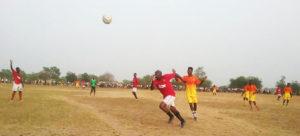
This year’s Feok games were organized among communities in Sandema. In all 12 teams participated. The teams were balloted into four groups of three teams each as follows: a) Kobdema/Longsa, Abil-yeri, and Kalijiisa
b) Bilinsa, Awusi-yeri, and Kori (Akag-yeri)
c) Suwarinsa, Kori (Alab-yeri), and Nyaansa
d) Kalibiisa, Balansa, and Kandema.
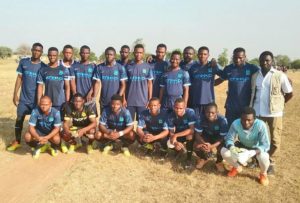
Team Balansa
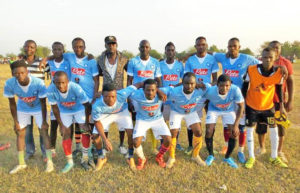
Team Abil-yeri
The tournament began on 22nd November 2018 at the Sandema Sports Stadium with the opening match between Kobdema and Abil-yeri which Abil-yeri won 2 – 1. After a very entertaining first round of games, Abil-yeri, Kobdema/Longsa, Bilinsa, Kori (Akak-yeri), Kori (Alab-yeri), Suwarinsa, Balansa, and Kalibiisa qualified to the quarterfinals (1/8th stage). The one-eighth round was played from 6th – 9th December and four teams qualified to the ¼ stage (semi-finals) namely, Kalibiisa, Balansa, Bilinsa, and Abil-yeri. These later stage games were more competitive, tense and nearly marred by controversies but were successfully played on the 14th and 15th December. Bilinsa and Kalibiisa overcame Balansa and Abil-yeri respectively to reach the final. Both Abil-yeri and Balansa who were scheduled to play for 3rd place on 18th December, however, boycotted the game and it was duly cancelled. However, the final came off on 19th December between Kalibiisa and Bilinsa. The game ended 1- 1 after regulation time and the teams had to resort to the drama of penalties. After a nerve racking shoot-out, Kalibiisa emerged as worthy winners. All games were well patronised by all and sundry and the district police were there to ensure law and order.
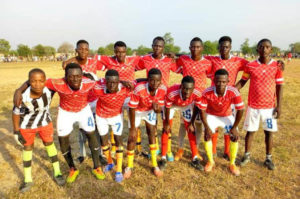
Team Bilinsa (second place)
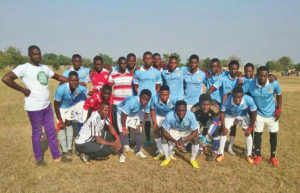
Team Kalibiisa (the winners)
a) Stats from the competition
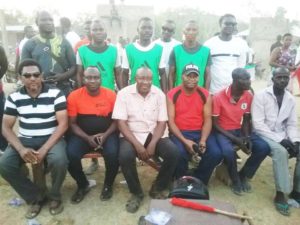
Hon. DCE in attendance at Feok Games
Number of games played: 19
Goals scored in group stages: 37
Goals scored at 1/8th stage: 5
Goals scored in the Final: 2
Total goals scored in competition: 44
Number of games won in regulation time: 14
Number of games won by penalty shoot-out: 5
Number of Yellow cards shown: 13
Number of Red Cards shown: 4
b) Prizes
Winners (Kalibiisa) – 2 (two) sets of jerseys and a football
2nd Place (Bilinsa) – 1 (one) set of jersey and a football.
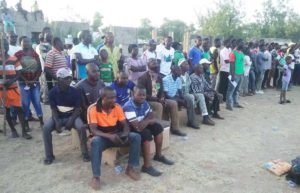
Cross section of fans
c) Organizing Committee of Feok Games 2018
1. Ajuik Anamsichaab – Chairman
2. Abudu Imoro
3. Amoak Roland
4. Adumpo Cornelius
5. Ayaya Johnson
6. Adjonab Martin
7. Salifu Baba
8. Dero
9. Sunday Latif (PRO)
II. The Archery Competition
This year’s archery competition came off on 19th December, a day to the grand durbar, rather than the usual practice of holding it after the durbar. It was keenly contested and won by a man from Sandema Abil-yeri. The change of date/day affected attendance a bit but the main discomfort of most of those who attended was the dress code of the participants. Many participants were considered to be improperly dressed as they were not in the war regalia.
III. Launch of Queen Mothers’ Association and Kitchen
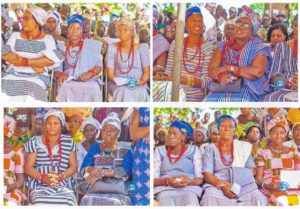
This program came off at the CONIFAH Guest House in Sandema on 18th December. It was attended by the high and mighty of the land and the queen mothers (pok-nalima) were indeed elegant both in appearance and in their cooking skills. The guest of honour was the Upper East regional minister, Hon. Paulina Abayage, and the event was chaired by the former MP for Bulsa North, Mrs Agnes Chigabatia Asangalisa. The pok-nalima prepared different types of Bulsa dishes which were sampled and enjoyed by the invited guests. The Queen mother of Sandema was elected as the president of the Bulsa Queen Mothers’ Association. The Queen mothers’ kitchen is an excellent exhibition that should be encouraged and supported to spice up subsequent celebrations of Feok. Congratulations to all the Queen Mothers of Buluk and their leadership.
IV. Symposium on Alternative Dispute Resolution
The Bulubisa Club, organizers of the recent Bulsa Cultural Celebration in Accra, teamed up with the Feok Organizing Committee to organize a symposium at the Azenero Social Centre in Sandema on 19th December 2018. The
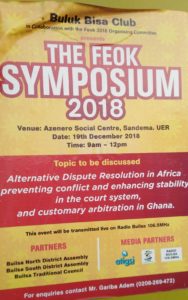
symposium discussed the theme: “Alternative Dispute Resolution (ADR) in Africa: Preventing conflict and enhancing stability in the court system, and customary arbitration in Ghana.” It was moderated by His Worship Seth Aduedem Alafa, a district court magistrate based at Akosombo. The event was transmitted live on Radio Builsa 106.5FM. The discussion highlighted the rules of ADR, the cases that may and may not be resolved with ADR (e.g. family feuds and criminal cases respectively), and the advantages of the ADR system, among others. Attendance to the programme was however poor as it was the same day and time as the archery competition. Better communication and planning is necessary to ensure that Buluk benefits fully from all aspects of the Feok celebration in the future.
V. The Grand Durbar
The ultimate durbar of chiefs, queen mothers, and Bulsa people came off on the 20th of December at the Sandema durbar grounds. To the credit of the organizing committee, the grounds were ready ahead of time. Tents/Canopies, chairs, banners and all were organized on time and the grounds were watered several times to reduce dust pollution during the day’s activities. As usual and in consonance with the theme of Feok 2018, the Bulsa culture was at its best with various communities, cultural groups and dance ensembles displaying Bulsa attire, drumming, dancing and singing to the admiration of all. The durbar was graced by the president of Ghana, His Excellency Nana Addo Dankwa Akufo Addo who was the Special Guest of Honour. It was the first time in over twenty years that a sitting president was attending the durbar.
The coming of the president was important for Buluk. As a foretaste of what was to come, a few days to the durbar, there was renewed activity on the Navrongo – Sandema road and commuters gained some respite as local politicians and contractors rushed to mend the rough road to make for a smooth passage for the president and his entourage. The presence of such an august personality also gave the Feok a national and international appeal as the major media houses in the country turned their lenses on Buluk and the Feok Festival. The president was presented with the horned-helmet (zuchiak) which is the greatest symbol of Bulsa gallantry. Kudos to the organizing committee, the chiefs, political leaders and all those who played a role in making this possible.
The Speeches
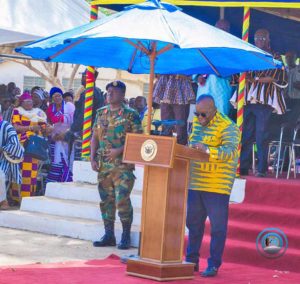
The President giving his speech
The Sandem-nab and Overlord of the Bulsa Traditional area, Nab Azagsuk Azantilow II gave a most eloquent speech in which he commended the President for a number of social interventions which he said will improve the well-being of Ghanaians and Bulsa people. These included the “One Village, One Dam”, “One District, One Factory”, Planting for Food and Jobs, and Warehouse projects. He appealed to all Bulsa and Ghanaians to support the projects. He also called on the president to do more to alleviate poverty in Buluk but also challenged his people to rise up in arms against contemporary enemies of the Bulsa such as alcoholism and other social vices. In the words of the paramount chief, “the slave raiders are long gone but alcohol abuse and bush burning are now our slave raiders terrorizing us”. Nab Azagsuk called on the president to use his office and the state machinery to intervene to stem the tide of bush burning in Buluk and Northern Ghana as a whole.
President Nana Addo Dankwa Akufo Addo also gave an eloquent speech often interrupted with applause as he announced several development projects that would be carried out in the Bulsa districts. Among them were the long awaited and much politicized Navrongo- Wiesi road project. The President said the road was part of the national trunk road N10, and that 10 kilometers of it had been awarded to Messrs Deliman Limited, and the other 40 kilometer stretch to Myturn Limited. The contract of Messrs Deliman Limited was however abrogated for nonperformance and re-awarded to Myturn. A contract had also been awarded to Munck Engineering of Denmark at a cost of €2.2 million for the construction of a bridge over the Santejan river at Doninga, and was expected to be completed in 24 months, whilst the Ghana Education Trust Fund (GETFund) had been directed to ensure the completion of the ongoing Chuchuliga Senior High School project, which was initiated by the community. In addition, the Wiaga Community Senior High School which is also a community self-help project is under consideration to be absorbed into the public school system. The President also revealed that his Government plans to set up 200 agricultural mechanization centres across the country, and the Bulsa North District would be one of the beneficiaries. To put the icing on the cake, he announced that the Builsa North District was to be elevated into a municipality and a request for the construction of a district hospital in Builsa South District was being considered.
The President then made a donation of GHC 10, 000 and assorted drinks to support the celebration of Feok 2018!
VI. The Sights, Sounds and Glitter of the Day
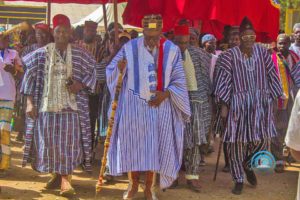
The Sandemnab and his entourage of chiefs
All the chiefs of Buluk turned out in rich and beautiful smocks with matching shoes. They all looked dignified and magnificent with their elders. Even more impressive were the pok-nalima (queen mothers) who caught the attention of all, looking so beautiful in their flamboyant ‘gangsa’ with colourful beads and head wrappers to match. One could not help but feel proud at the sight of them. Aside the traditional rulers, there were also many local and regional politicians across the political divide and hundreds of Bulsa in traditional attire; men in different types of smocks and women in gangsa and other glitzy dresses. The
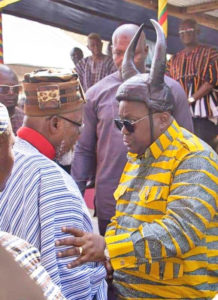
The Sandemnab (left) and the President (right) with a Bulsa war-helmet
Kantoosi/Yarisa were present in their numbers as was their dancing troupe whose popularity grows every year as they turn out in large colourful smocks to spice the celebration with their unique dance. They are always a delightful spectacle! There was also a large number of young people and women dressed in the colours of the governing New Patriotic Party, organized no doubt by the leaders of the party in the district to catch the attention of the president during his visit. The most spectacular sight however was that of the war-dancers in their curious attire; the saba-smock (saba-garuk), the collections of quivers (logta) and the imposing horned helmets (zuchaasa). There was an impressive presence of youth in the war-dancing troupes which gives credence to the Bulsa proverb that “Ba kan de korum a mini biiga” to wit, “we do not eat culture without inviting children”. The youth have a crucial role to play in cultural transmission and should be encouraged to do more.
There were also many drumming and dancing troupes with different instruments including: goa (calabash drums), gungona (hourglass drums), wiisa (flutes), namunsa (side-blown horn trumpets). Though there was not much drumming and dancing in the official program, the sounds of these ensembles were heard all around the durbar grounds. During the ceremonial war-dance to conclude the durbar, the unique sounds of the various war-dancing companies were intermingled into one exciting war-dance tune with the single flutes calling: “Ti laa Azantilow! Ti laa Azantilow! Tugurika tommu! bai li kuli, bai kan kuli! peema zik chaab ka dela”! (Azantilow, Azantilow, the war-troupes have gathered, some will return home and others will not, arrows have met each other here). Those are the sounds that speak to the heart of the Bulsa and make Feok such a uniquely remarkable celebration. A thick cloud of dust rose from the durbar ground and hung over the air all night whilst people trooped into the market place to dance, drink, eat, and make merry. Long after midnight, the whistles/flutes, drums and war cries were still heard as the dance parties, now whittled down to only a few members each, made their way home.
VII. The Miss Feok Beauty Pageant
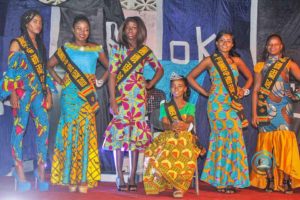
The 2018 and 2017 winners and runners up
This year’s edition of Miss Feok came off successfully at the Good Family Lodge on 26th December. It was on the theme: “Entertainment as a tool for development”. Several Bulsa girls displayed talents and knowledge of Bulsa culture, dance, music and lifestyle to the admiration of patrons. There were also performances by contemporary music artistes of Bulsa origin which kept patrons and contestants dancing long after the programme had ended. The aim of the pageant, according to the organizers, was to select an ambassador who would champion the development of Buluk, one problem at a time. To this end, the 2018 project aimed to promote ‘quality education for all!’ especially at the basic school level. This was meant to build upon the 2017 project which was aimed at sensitizing basic school children on the dangers of early sex and teenage pregnancy. The organizers carried their message round several basic schools throughout Buluk to sensitize school children and community members and to encourage young girls to exhibit their talents by participating in the pageant. Some of the slogans of the sensitization campaign such as: “Books before Babies” and “Grade Six not Sex” are most apt especially as cases of child marriage, teenage pregnancies and abduction of school children are still being practiced in some parts of Buluk. This event is gradually gaining grounds not only as a source of entertainment, culture and talent but also of education. It is definitely a useful addition to Feok celebrations and should be supported by all and sundry to make it bigger and better. Kudos (thanks) to the organizers: Kandy Mega Media, T. S. Klan Entertainment and their partners for their tireless efforts.
The 2018 contestants include: Anyasuik-bey Benedicta, Anaamlie, Freda Amidu, Angela (Najat), Alimsiwen (Justina), and Priscilla (Milky). Miss Anaamlie emerged the winner and received a brand new motorbike as her prize.
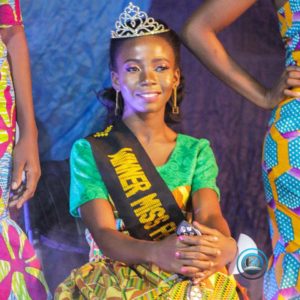
Anaamlie – winner of Miss Feok 2018
VIII. Some Observations and Matters Arising
All in all, the celebration of Feok 2018 will go down as a huge success most especially since the President of the Republic was present. We strongly share this sentiment. However, we also observed a couple of things and heard a number of criticisms and discontentment which deserve mention in the hope that future celebrations can be improved for the benefit of Buluk and all.
1. The first observable fact of concern is that despite the apt theme for the celebration, no identifiable community initiative or self-help project had been targeted. This always subtracts from the purpose of the celebration in general. If our chiefs and political leaders can identify one project each year to be launched during the Feok, it would go a long way to encourage people to donate resources. Such projects would have general support and communal labour can easily be mobilized to help. Self-reliance must be incorporated into our social fabric whilst the concept of depending on either central government or the district assembly for everything should be discarded or at most reduced to the barest.
2. A general concern from many people at the durbar was that the MCs did not give enough recognition to the new institution of ‘Pok-nalima’ (Queen mothers). Many people, especially gender advocates find this appalling. Indeed, this is unacceptable and if the new institution is to be effective within our traditional authority set-up, we must seize every occasion to project them and encourage them. We wish to appeal to their male counterparts (the chiefs), the district assembly, NGOs and prominent people in Buluk to seek out opportunities to have our Pok-nalima participate in capacity building activities and trainings that would equip them with the necessary skills and knowledge to play their elevated roles effectively. It is our humble opinion that if the Pok-nalima had been properly schooled about their identity as chiefs, they would have risen with their male counterparts to welcome the President and to participate in the giving of gifts. In future celebrations, we should consider allowing the Pok-nalima nab (president of the queen mothers association) to make a speech during the durbar.
3. There was also widespread criticism about a lack of sufficient time for actual war-dancing by all the dance troupes during the durbar. In recent times, this has been a regular concern. Part of the reason for this is the lateness in beginning the durbar. Much of the blame for this lies at the feat of the political personalities usually invited as Guests of Honour. They are almost always late! Either we learn to start our program without them (we can allow the war-dancing to start first thing) or allocate a different day for the war-dancing so that all the war-dance troupes can dance to their hearts’ content before the durbar. On the day of the durbar, we can have selected groups dance. The selection of these groups can be on a rotational basis to give equal opportunity to all communities.
4. Another section of celebrants at the festival are of the opinion that the MP for the Bulsa North Constituency was not adequately acknowledged and was not allowed to make a speech. In as much as we need to be fair to all manner of persons during the celebration of Feok, we would call for caution. The celebration shouldn’t be seen as an avenue for politicking (except when it is unavoidable). We now have two constituencies in the Bulsa area. If MPs are to be allowed to speak to their constituents during the celebration, we could be heading for trouble especially if we grow beyond two constituencies and have MPs across the political divide. In our opinion, an MP should not automatically be allowed to speak unless he/she is a guest speaker or guest of honour. We should rather get into the habit of introducing them in a special way and giving them a voice through other activities as part of the celebration such as radio talk shows/discussion, having them launch communal projects during the durbar etc.
5. Closely related to the issue of the MP and politicking during Feok was the overwhelming presence of young people and women in NPP colours at the durbar. Many have called this counter-productive and a recipe for disaster and rightly so. We may pretend that it is freedom of expression and of association and need not be a cause to worry, but we should also be aware of the polarized nature of our society and how easy it is for such expression of political partisanship to degenerate into violence. The almost extreme paranoia displayed by some people especially those on the other side of the political divide and the equally spirited defense put up by supporters of the said group shows how divided we are. These ‘attacks’ and ‘defenses’ often lead to a game of political equalization and may embolden people to exhibit even more irksome behavior. We fear that if this is not nipped in the bud, the eminent election of MMDCEs (Metropolitan, municipal and district chief executives) along political party lines could worsen political expression at subsequent Feok celebrations. The traditional council, the district assemblies and all other stakeholders must commit to abort this monstrous foetus before it matures into a devouring beast. At all cost, we must depoliticize Feok!
6. Another disturbing issue that was noised abroad which is woven into all the issues above concerns an alleged interference in the work of the organizing committee by political entities. This is not only with the 2018 Feok but runs through all the celebrations in the post Nab Sir Azantilow Ayieta era. Members of some previous committees have alleged that the committees are often constrained in what they can implement and resources are withheld if they did not conform to demands of some persons. Sometimes a few persons ‘hijack’ the committee and proceed to dictate what must and must not happen. Some previous members have vowed never to serve on the committee again even if they are invited. Whether these complaints are genuine or not, it points to a worrying trend that must be checked. We cannot hope to have a successful celebration if we constitute the organizing committee and then proceed to shackle them so that they cannot introduce reforms and new ideas for our growth and development. As suggested by the acclaimed genius Albert Einstein, “the definition of insanity is doing the same thing over and over again and expecting a different result”.
7. The last but not the least is an issue dear to the hearts of a growing number of Bulsa, namely; the inability of the organizers of Feok 2018 to allocate space for the Bulsa Heritage and Cultural Society (BHCS) to exhibit Bulsa material objects as part of the durbar. No clear reason was given for this and it appears to be the result of a miscommunication between the organizing committee, the paramount chief and the BHCS. The exhibition was eventually staged outside the durbar and though it still drew a large crowd of curious visitors, it was effectively shielded from official ‘sight’. It would have been a very positive exposure if the exhibition table was within the durbar grounds and the president and his entourage were impressed upon to pay even a brief visit. An exhibition of material objects could be one of the ways to spice up the Feok celebration and attract tourists. It is therefore imperative for future organizing committees to dialogue with the BHCS to find ways of incorporating it into the celebration.
In conclusion, we wish to express much thanks to the nalima (chiefs), pok-nalima (queen mothers), kanbong-nalima (divisional chiefs), the Bulsa North and South district assemblies, the 2018 Feok organizing committee, the political leadership of Buluk, and all those who contributed in diverse ways to make Feok 2018 a memorable celebration. Congratulations to all Bulsa!! Let us bury any differences between and among us and bear neither griefs nor grudges but look forward to the next Feok with eagerness, learning from our mistakes of the past to improve our festival and harness it for our collective development. Zurugaluu, lam kan be!
IX. Members of Feok 2018 Organizing Committee
George Amarnah – Chairman
Daniel Achaab Adams – Secretary
Mad. Catherine Abas – Member
Lucas Alakawo – Builsa North Assembly Rep
Bright Anko – Builsa South Assembly Rep
Sources: Photos of the queen mothers, the durbar, chiefs and Miss Feok by courtesy of Kandy Mega Media. The photos of the football teams were taken by Sunday Latif, the image of the symposium poster by John Agandin.
- Contents of BULUK 12
- Editorial
- Events
- Who on Earth is interested in the Bulsa?
- Discussions in the Facebook Group “BULUK KANIAK”
- New Published and Unpublished Studies on Bulsa Culture
- The Sights, Sounds and Glitter of Feok 2018
- Report on BHCS Exhibition of Bulsa Material Objects at Feok 2018 in Sandema
- Bulsa Pomp and Pageantry
- John A. Agandin: Two Poems
- The Medical System of the Bulsa
- List of Plants for Medicine and Other Purposes
- Dental Health – the next lifestyle disease?
- Free surgical procedures by Dr. Benjamin Akinkang’s Team of Hope
- Ambulance not on the Road: A Disgrace to Health Care for Buluk
- Management of Perceived Malaria Infections in Children among Bulsa Mothers